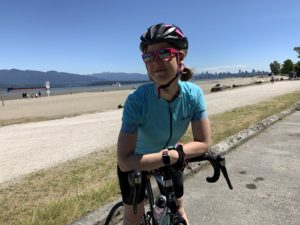Katie went for a 90-minute run. Her blood sugars were pretty good throughout thanks to various diabetes and exercise strategies. However, when Katie finished the run, her blood sugars started skyrocketing within 15 minutes of completion – all thanks to exercise-induced hyperglycemia.
What is the deal with high blood sugars post exercise?

Balancing the benefits and challenges of exercise
Exercise has widely been promoted as a benefit for blood-sugar management in people with type-1 diabetes.
And rightfully so.
Regular physical activity can increase insulin sensitivity, which can help improve blood sugars. It’s also beneficial on our mental and physical health, and can reduce risk of cardiovascular disease and other potential diabetes-related complications.
But, exercise is also super challenging to manage with T1D.
Today, I want to focus on the specific challenges of exercise-induced hyperglycemia.
Causes of hyperglycemia with exercise
When we think of high blood sugars and exercise, usually the first thing that comes to mind is high-intensity interval training (HIIT).
This includes activities like circuit training, vigorous weight training, sprints, and tabata. It’s essentially anything that gets your heart pumping and your breathing laboured for a short period of time, on repeat.
The reason for this is stress.
Although beneficial, these high-intensity sessions are super stressful on the body in the immediate sense. And because of that, our stress hormones increase. And these hormones have the effect of impairing glucose uptake into muscles, thereby causing high blood sugars.
This aspect of hyperglycemia and exercise is well researched and pretty well known in the T1D community.
But did you know that prolonged moderate-intensity exercise can also cause exercise-induced hyperglycemia?
Yes folks, that’s right.
And the reason for this is due to of our strategies for reducing the risk of low blood sugars during exercise.
What the heck?
Damned if we do. Damned if we don’t.
Below is a list of some of the evidence-based, recommended strategies for reducing hypoglycemia during prolonged cardio workouts:
- Reduce meal-time insulin by 50-75% for exercise lasting longer than 60 minutes if the meal is within 90 minutes of exercise
- Decrease basal rate by 50-80% 60-90 minutes before starting exercise for activities longer than 30 minutes
- Eat fast-acting, low-fibre carbohydrates before and during exercise without insulin provision
Looking at this list, what do you think the issue is with regards to a delayed hyperglycemia?
Clearly, it’s insulin deficiency, right.
All of these strategies reduce how much insulin we have circulating in our blood. When we’re exercising, these strategies are great because the less insulin we have circulating, the less likely we are to have low blood sugars.
But as soon as we stop exercising, the low levels of insulin in our system is a recipe for havoc on blood glucose.
For one, digestion is often delayed during aerobic sport. So if we’ve eaten carbs immediately before and during exercise, we will still be digesting and absorbing them after exercise, but won’t have the insulin to cover them.
Then, once our bodies stop moving there’s no longer this quick glucose uptake to the muscles.
It’s a recipe for blood-sugar sludge, also know as exercise-induced hyperglycemia.

Managing exercise induced hyperglycemia
I would love to be able to give you a tried and true strategy to manage high blood sugars post exercise that I know would be successful for all. But unfortunately, as is all things with T1D, it’s not that easy.
Friends, we are all different and so is our type-1 diabetes. That means trial and error is imperative here.
Do I sound like a broken record? I feel like I’m always chirping about trial and error … probably because I am 😉
It is the number one strategy for managing exercise with T1D.
While there is a lot of researched recommendations for managing low blood sugars during sport, as well as managing nocturnal hypoglycemia several hours after sport, there’s not a lot in the way of managing exercise-induced hyperglycemia – especially in the context of prolonged aerobic exercise.
And the limited studies that have been conducted are challenged by:
- Small population size, which means the T1D representation is limited
- Controlled environment, which does not necessarily mean results can be reproduced in real life settings
- Lacking individuality. T1D is not a general, textbook disease, therefore what worked for those in these studies, may not work for others
Strategies I’ve trialed in the past have included:
- Turning off temporary basal rates 15-30 minutes before completing exercise
- Increasing basal rates for 1-2 hours after exercise
- Bolusing a percentage of the foods consumed before and during exercise that was not bolused for previously
Some have worked well, while others haven’t worked as well. The ones that do work well don’t consistently work well. And they all require super close monitoring of blood sugars for several hours after, because of increased risk of delayed hypoglycemia.
My trial and error strategies are continuously evolving.
And that, my friends, is why I continue to advocate for including trial and error into your T1D and exercise management strategies.
** The above is not medical advice. I highly recommend working directly with your healthcare team, including a registered dietitian, for guidance specific to your T1D and exercise needs **

